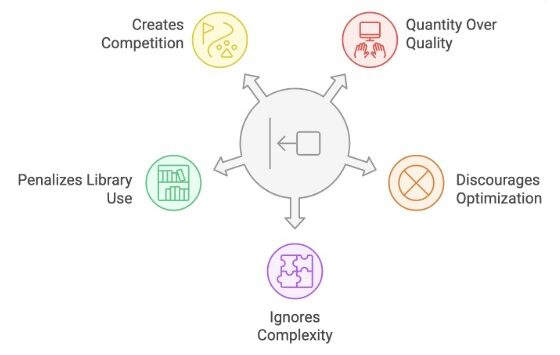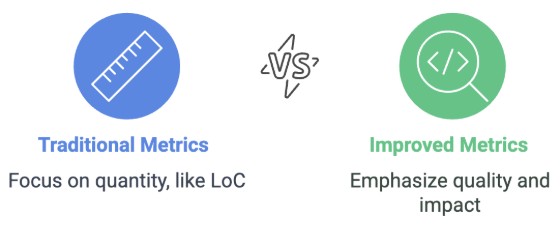Why is LoC bad as an individual metric of productivity?
Status
answered
Status
answered
Measuring software development productivity isn’t easy. Many organizations and managers have tried using lines of code (LoC) to measure developer output. At first, this might seem logical since more code should mean more work, right?
However, relying on LoC as a productivity metric is misleading. Writing more code doesn’t always mean better results, and in many cases, less code is actually more efficient.
Lines of code (LoC) refers to the number of lines written in a program, including:
Many organizations have historically used LoC as a productivity metric, assuming that writing more code signifies higher efficiency.

A higher number of lines does not equal better software. Consider these two scenarios:
Which one is more productive? Developer B is delivering more value with fewer lines. Prioritizing LoC may encourage bloated, unnecessary code instead of clean, maintainable solutions.
One key principle of good software development is writing fewer lines of better code. Refactoring is often used to improve code performance, readability, and maintainability. In most cases, refactoring reduces LoC significantly.
So, if developers are judged based on the number of lines they write, they may avoid necessary refactoring efforts to maintain a high LoC count.
Writing software isn’t just about adding lines but solving problems. Consider the following:
LoC does not capture the thought process, problem-solving, or debugging efforts that go into software development.
Modern software development involves using frameworks, libraries, and APIs to streamline development and improve efficiency. A developer who writes concise, efficient code using libraries might produce fewer lines than one who writes everything from scratch. However, the former is more efficient and follows best practices.
If developers are evaluated solely based on LoC, they may feel pressured to:
Such competition fosters a toxic work environment rather than encouraging meaningful contributions.

Since LoC is an inadequate metric, what should organizations use instead? Here are better alternatives:
Instead of counting lines, focus on how well the code is written:
Measure productivity based on actual contributions:
Encouraging a culture of code reviews ensures quality and collaboration. Metrics like number of successful pull requests, constructive feedback received and given, and engagement in team discussions are far more valuable than counting lines of code.
Tracking how quickly and effectively a developer resolves issues provides a realistic measure of productivity. Solving critical bugs in a few lines of code is often more impactful than writing hundreds of new lines.
A productive developer is not just one who writes a lot of code but collaborates effectively and enjoys their work. Metrics like team collaboration and contributions, participation in technical discussions, and overall job satisfaction provide a holistic view of developer productivity.
LoC is an outdated and misleading metric for measuring software development productivity. It encourages bad coding practices, ignores problem-solving efforts, and discourages refactoring. Instead, organizations should focus on code quality, problem-solving skills, feature completion, and collaboration to effectively measure developer contributions.
Evaluating developers should be about impact, not just output. So, let’s move beyond LoC as a metric and foster a more meaningful approach to software engineering.
